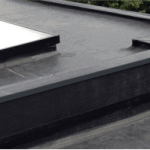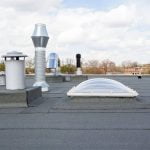Causes Of Roof Damage
Many homeowners aren’t proactive about roof maintenance; it isn’t until standing with a bucket in hand, cursing, and water dripping that they wish they hadn’t neglected it.
It can’t be stressed enough that if ignored, roof damage can cause more significant problems in the future and result in considerable costs. If you deal with the issue in time, it might save you thousands of pounds and all the inconvenience it may cause you and your family. Once you have identified the issue, you can either deal with it yourself or hire a roofing contractor, depending on the scope of the damage.
Most Common Causes of Roof Damage
Below are seven of the most common causes of roof damage to look out for and how to spot them before they drain your bank account.
Improper Installation and Repair
Often, roof damage can be due to the initial installation not being performed correctly. Even so-called ‘roofing experts’ might not be the professionals you think they are. It’s always best to thoroughly vet any contractor or roofing company you consider hiring.
Homeowners trying to fix leaks and roof repairs themselves are often the biggest culprit or getting a friend or guy down the road ‘who knows what he is doing to repair it because they are cheap. This false economy often ends in disaster.
Insurance claims can be invalidated if you try to DIY the task and working at height can be dangerous. Take a look at the roof to inspect it but then leave it in the hands of the professionals to repair it unless you are totally confident in what you are doing. It might be that you repair one leak but miss other issues that might cause more substantial damage in the future.
Lack of Roof Maintenance
Prevention is the best cure; this term doesn’t just apply to your health but your roof as well. Roof inspection and maintenance should be performed regularly. If any damage is discovered early enough, it can be resolved before it leads to more significant issues. Inspections should be at least yearly and after adverse weather conditions such as storms, hail, or high winds.
If you inspect the roof for wear and tear yourself, you should look out for loose and missing nails and tiles, areas of rot and holes, and cracks. Besides exterior checks, it is wise to give the inside of your home a once over, especially in the loft for signs of leakage or water stains on the ceiling or walls.
Clogged Gutters
Clogged gutters can often cause roof damage if the gutter becomes clogged with leaves. Instead of the gutter draining the water away from the roof as it should, it will pool on the roof in certain areas, resulting in a weakening of the roof, rotting and leaks.
Fortunately, it’s easy to deal with. During spring or autumn, gutters are more likely to be clogged due to falling leaves and storms. You’ll probably see leaves poking out of your gutter so it will be a clear indication that it needs declogging.
You can either get a ladder up yourself and clear the blockage or pay a tradesman or someone experienced with heights to do the job for you. It doesn’t need professional expertise, but it could be a good time to have a roofing company clear the gutters and inspect the roof at the same time.
Extreme Weather Conditions
Luckily, we don’t get the adverse weather conditions that many other countries face around the globe. We occasionally might get the tail end of a hurricane and the few tornadoes that hit the UK each year but they aren’t the powerful types that cause untold damage in countries like the USA.
Still, the varied weather conditions we experience, such as storms, high winds, snow, strong rain, hail, and even hot summer temperatures, can damage our roofs over the long term and are among the leading causes of roof damage.
Hail damage can wreck havoc on shingle roofs. A sudden hailstorm can displace the granules on the surface that protect the asphalt layer from the sun, exposing the asphalt layer to damaging UV light. It has also been known to crack roof tiles.
The cold months are typically when the majority of roof damage is caused. Snow can put pressure on a roof as well as melt and pool water on it. Water freezing between roof materials can often cause damage.
Storms and high winds can damage your roof. Strong wind can dislodge and lift tiles and shingles. Debris can land on the roof and damage it, typically from tree branches. Heavy rainfall can cause all sorts of roof problems and water damage. Rain is your roof’s nemesis. Signs of rain damage include leaks, mold, and rotting.
Some risks can even go unnoticed, such as pollutants in the air that can wear down certain roofing materials over time.
The Age of The Roof
All roofs, whatever the quality of the material and however well they were installed, will eventually show signs of wear and tear. Rather than leave it for too long, if your warranty is up, it might be time to look to replace it before the roof leaks and proves even more costly.
Different roofing materials have become more popular in recent years due to their longevity and durability. For instance, more homeowners choose rubber roofing systems, especially for flat roofs and house extensions. EPDM (Ethylene Propylene Diene Monomer) has a life expectancy of 50 years and is deficient maintenance. EPDM is also waterproof and environmentally friendly, making it a perfect roofing material.
If you continually make minor roof repairs, it might be time to invest in a new one, especially with today’s modern solutions. A new roof for your home might not only save costly repairs, but it might also improve its aesthetic appeal.
Too Much Foot Traffic
Roofing material can be fragile, so walking on it should be avoided. Homeowners shouldn’t be on the roof at all, but if you do, ensure that your footwear is right for the task; soft and high-traction shoes are required. Trained roofing contractors will know exactly where to step and the places to avoid on a roof, so if you can leave it to the professionals, then do so.
Roof Flashing is Damaged
Last on our list of roofing damage causes is one that often goes unnoticed; damage to the roof flashing. Roof flashing is thin sheets of metal installed beneath the shingles. It protects the internal structure of the roof from water damage by creating a barrier. Damage to the roof flashing is typically located in areas around vents, chimneys, and skylights, and on the edge of the roof. Roof flashing may deteriorate over time or tear or rust, so it is worth keeping an eye on it to prevent water from leaking into your home.
In Summary
These seven common causes of roof damage are the most likely, but other factors might come into play, so the list is not exhaustive. To ensure that your roof lasts for decades to come, you should regularly inspect it or even better have a professional roofing company perform the service. They’ll have the expertise and tools to inspect your roof thoroughly and perform any necessary repairs.
If you think you might need a new roof, consider a modern solution, such as rubber, which has a lifespan of 50 years or more.






